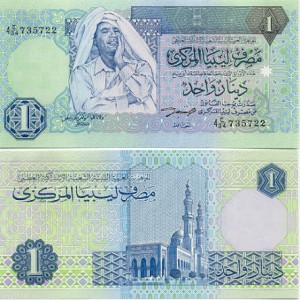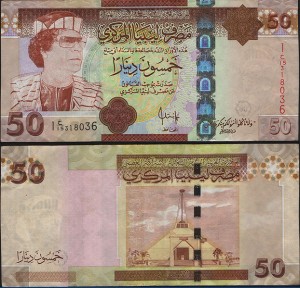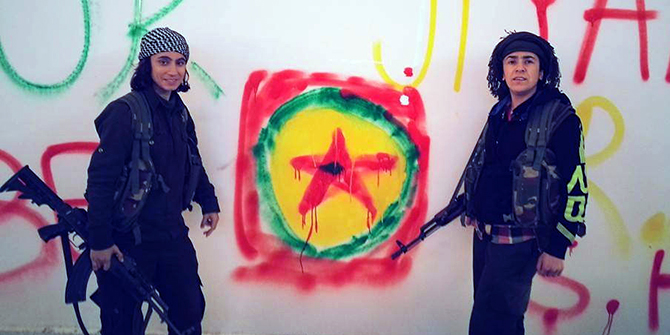On 11 June, the LSE Middle East Centre will host this year’s BRISMES Graduate Section Conference. The conference will feature more than 50 up and coming scholars presenting their research and analysis on the Middle East and North Africa. Leading up to the conference, we’ll be featuring some sneak peeks from presenters. We hope to see you there.
By Dr Rebecca Dodd
Money is an everyday object, something we take for granted, and yet every image on money is innately political. One of the earliest policies put in place by the new Libyan government was to recall banknotes of the Gaddafi era and to replace outdated imagery where necessary. It must be remembered that the destruction of Gaddafi-related imagery — whether in terms of the old Libyan flag, the Green Book, or his many public portraits — was a significant component in the Libyan uprisings: therefore recalling banknotes bearing his likeness should be viewed as part of a wider continuum.
There are different methods for choosing imagery on money. Portraiture is perhaps the most significant manifestation of political propaganda on money. There are two basic models: historical and contemporary. The contemporary model shows the current leader, which is the basic model for UK currency. This model serves to give a clear indication of who leads a country at any given time. In contrast, the historical model shows a past leader, the favoured model for the USA. This is slightly more politically neutral than the more obvious contemporary model. Often the two models are mixed, and this was certainly the case with Gaddafi, and for Libyan money generally.
Following on from the historical model, historical monuments often feature on money, as does other national heraldry. However, not all imagery on money need be as obviously political as has thus far been suggested: some numismatic imagery is simpler, and yet still reflects something specific to the nation.
A Brief History of Libyan Money
Prior to Gaddafi, a mixed historical and contemporary model was in place. A banknote from 1952, for example, depicts King Idris (Figure 1). However, King Idris also issued far more politically neutral coinage such as the note in Figure 2, which depicts the Libyan coat of arms, as well as the perhaps less political images of palm trees.
 |
 |
| Figure 1: www.banknotes.com/LY12.JPG | Figure 2: www.banknotes.com/ly27.html |

The rise of Gaddafi brought about a complete change in Libyan currency from the Libyan pound to the Libyan dinar, and most of the old imagery, including King Idris, disappeared as well. Despite his reputation as a dictator, Gaddafi did not put his image on banknotes immediately, preferring instead to use the historical model.[1] Gaddafi’s icon of choice was Omar Mukhtar (Figure 3), the key figure in the Libyan resistance movement which started in 1911 and ended in 1943. Ideologically, the image of Mukhtar was universally appealing to Libyans; at the early stages of Gaddafi’s rule an image of the new leader would have been controversial. However, the image of Mukhtar may also have been part of Gaddafi’s larger pro-Libyan vision. In this context, the use of an historical figure may reflect a wider pro-Libyan policy, rather than simply a pro-Gaddafi agenda. In any case, the image of Mukhtar became a central facet of Libyan political and monetary culture; in fact, banknotes were often referred to as ‘Mukhtar’.
Other Libyan imagery was used as well. Figure 4, for example, depicts an oil refinery, perhaps symbolic of the nation’s wealth, but also reflective of Gaddafi’s early policies of taking a greater share from western oil companies.[2] The banknote depicted in Figure 5 features a mosque on the reverse, with ruins of an historical monument on the obverse. Both of these items are Libyan in nature, and form a part of cultural history, in addition to the political and economic reflected in other contemporary notes.
 |
 |
| Figure 4: www.banknotes.com/LY43.JPG | Figure 5: www.banknotes.com/LY47.JPG |
Not all banknotes are as overtly political. While the camel is a very popular image on Middle Eastern money, Libya may be unique for its depiction of a mother camel and baby (Figure 6).

As early as 1989, Gaddafi began to issue banknotes bearing his image. This change may reflect Gaddafi’s increased confidence after 20 years in power. Over time, he changed his image, as evidenced by Figures 7 and 8. The banknote in Figure 8 was possibly printed in anticipation of the 40th anniversary of his accession to power. The simplest explanation for this change in imagery is that it indeed reflected reality; however, a changing ruler portrait also demonstrates longevity. The ideological implications of Gaddafi’s changing appearance will be discussed in further detail as this research progresses.
 |
 |
| Figure 7: www.banknotes.com/LY59.JPG | Figure 8: http://en.wikipedia.org |
After the Arab Spring

With the ousting of Gaddafi, notes containing his image immediately became outdated. The Central Bank of Libya has already withdrawn the 50 dinar notes containing Gaddafi’s image; the bank announced this in January 2012, with a deadline of 15 March 2012. The ideological reasons for this are obvious. As Central Bank media manager Issam Buajila stated, “The one- and twenty-dinar notes will be phased out because these images remind the Libyans of the time of the dictatorship.” Indeed, banknotes are only one example of Gaddafi imagery that has been withdrawn or destroyed.
However, withdrawing money from circulation is not a simple process. Generally, the larger the note, the easier it is to withdraw. The one-dinar notes in Figure 7 still remain in circulation, as does the 20-dinar note (Figure 9) depicting Gaddafi along with the former Tunisian leader and other members of the Organisation of African Unity. Smaller notes are needed for everyday business in a way that larger notes are not, and so it remains to be seen how and when these will be replaced.
What will replace Gaddafi’s image? For the moment, the old Mukhtar and other notes with less political images remain ideologically neutral in contemporary Libya, and therefore are likely to remain in circulation. The continued use of old banknotes may well be not only due to the practical problems with withdrawing all currency, but also due to a desire not to introduce too much change too quickly. The Central Bank launched a competition in late 2011 for new banknote designs. The banknotes in Figure 10 may depict one of the new designs for Libya’s banknotes, though as of the date of writing, I have been unable to verify the authenticity of these via the Central Bank of Libya. Whether these designs will be used or not, numismatic imagery in Libya is clearly about to undergo a radical change and this will help illuminate thinking and ideology of the post-Gaddafi political leadership.
_____________________________________[1] Modern numismatics is an understudied field. Not all coins and banknotes from all countries are well documented, particularly outside their countries of origin. The Standard Catalogue of World Paper Money attempts to catalogue all current banknotes and is published on a roughly yearly basis. However, some editions do not represent all countries, and sometimes banknotes in circulation are not documented. [2] http://news.google.com/newspapers?id=yXBRAAAAIBAJ&sjid=Aw8EAAAAIBAJ&pg=7216,2358896&dq=gaddafi+oil+revenue+60+foreign+corporations&hl=en







